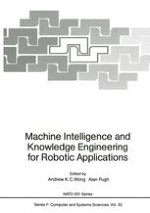1987 | OriginalPaper | Buchkapitel
Task and Path Planning for Mobile Robots
verfasst von : Raja Chatila, Georges Giralt
Erschienen in: Machine Intelligence and Knowledge Engineering for Robotic Applications
Verlag: Springer Berlin Heidelberg
Enthalten in: Professional Book Archive
Aktivieren Sie unsere intelligente Suche, um passende Fachinhalte oder Patente zu finden.
Wählen Sie Textabschnitte aus um mit Künstlicher Intelligenz passenden Patente zu finden. powered by
Markieren Sie Textabschnitte, um KI-gestützt weitere passende Inhalte zu finden. powered by
Autonomous mobile robots represent today a perfect paradigm for third generation robots and possibly the clearest case study for machine intelligence. They imply multi-level environment perception and modelling, decisional autonomy ranging from general planning to specific task operating, autonomous mobility capacity, sophisticated high level man-machine interface, and efficient execution control systems.This provides for a very large set of research issues as well as for the start up of a broad domain of real-world applications including projects which are outdoors oriented such as ALV and indoors or around-buildings oriented such as HILARE.Most of the concepts and results presented in this paper are general and can be extended such as to cover man-made and natural-like envionments. We have chosen to use a factory-like environment in which we hypothetically place HILARE, an autonomous mobile robot, as a case study. We also describe very briefly some of the main features of HILARE Mark II, the new experimental robot we have designed.In this framework we present a world model which includes: (i)a set of operators, which correspond to elementary tasks, e.g. primitive actions that will be used in the man-machine communication interface.(ii)a three-level environment model: geometrical, topological and semantic(iii)the functional capabilities of the machine, represented by a set of Specialized Processing Modules (SPM) and Specialized Decision Modules (SDM).The following section presents decision processes organization and inference mechanisms to achieve task and path planning. We stress the importance to produce at this stage an execution model that allows to implement an efficient execution control.To conclude, in the last section we consider the role of automatic acquisition and learning processes to build and update environment models, and to instanciate and to refine operator parameters.
